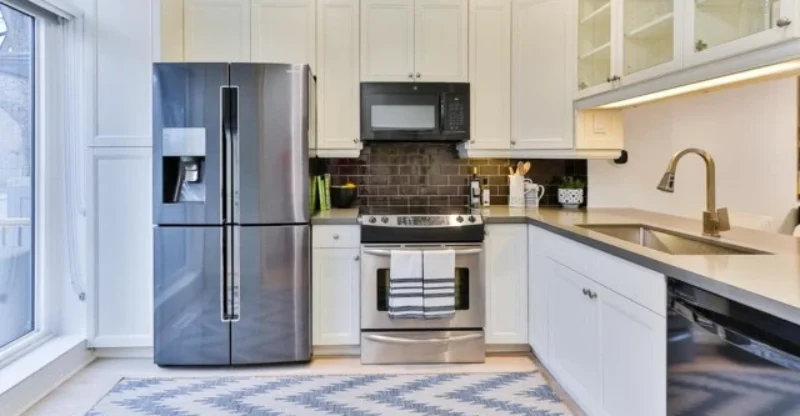Where To Place A Refrigerator In A Kitchen?
Are you wondering where to place a refrigerator in your kitchen? This seemingly simple decision can significantly impact its functionality and aesthetics. As a woman who loves her kitchen to be both practical and beautiful, you know that every detail matters.
Have you ever walked too far to get ingredients from the fridge while cooking? Or may your open fridge door become a roadblock in your kitchen?
If you’ve faced these issues, your refrigerator must likely be in the right place. In this comprehensive guide, we’ll explore the importance of refrigerator placement, factors to consider, and best practices to follow.
Whether designing a new kitchen or remodeling an existing one, this guide will help you find the perfect spot for your fridge.
Concept of the Kitchen Work Triangle
Kitchen designers swear by the kitchen work triangle. It’s a simple yet powerful idea that can transform the way you use your kitchen.
But what exactly is it?
Imagine drawing lines between your stove, sink, and refrigerator – the three most used areas in any kitchen.
The shape you get is a triangle, hence the name ‘kitchen work triangle.’ The idea is to keep these three points close enough for efficiency but not too close to avoid cramping.
The guidelines suggest that each side of the triangle should be at least 4 feet and at most 9 feet.
This ensures that you don’t have to walk too far when preparing meals and that you also have enough space to move around comfortably.
But remember, these are just guidelines. You might need to adjust depending on your kitchen’s size and layout. The key is to arrange your kitchen to make cooking meals smooth and effortless.
Factors to Consider When Placing a Refrigerator
Choosing the right spot for your refrigerator is more than just finding a place where it fits. Several factors come into play to ensure your kitchen is as functional and comfortable as possible.
Let’s explore these factors:
Kitchen Layout and Planning
The layout of your kitchen is the starting point. Depending on whether you have a galley kitchen, an L-shaped kitchen, or a U-shaped kitchen, your options for refrigerator placement will vary.
Always consider the overall flow of your kitchen. The refrigerator should be placed in a location that complements your kitchen’s layout and enhances its functionality.
Traffic Flow in the Kitchen
Think about the paths you most often take in your kitchen. You want your refrigerator to be clear of these paths or make your kitchen feel cramped.
Consider who uses the kitchen and how they use it. If you have kids who often access the fridge for snacks, it might be worth placing it where they can access it without disturbing the cooking area.
Proximity to Power Source and Ventilation
Your refrigerator must be near a power source and in a well-ventilated area. It should be placed away from heat sources such as the oven or direct sunlight to prevent it from overworking to maintain a cool temperature.
Proximity to the Cooking Area, Food Prep Counter, and Pantry
Your refrigerator should be near your food prep area and pantry for efficiency. It makes it easy to grab ingredients and put away groceries.
However, it should be a little far from the cooking area, so it’s hard to open the fridge door when the oven or stove is in use.
Avoiding High-Traffic Thoroughfares and Direct Sunlight
Finally, avoid placing your refrigerator in high-traffic areas where it might cause bottlenecks, especially when the door is open. Also, keep it out of direct sunlight to help it run more efficiently.
Best Practices for Refrigerator Placement
Now that we’ve covered the factors to consider let’s look at some best practices for refrigerator placement. These tips will help you find the perfect spot for your fridge, enhancing your kitchen’s functionality and aesthetics.
Common Refrigerator Placement Options
There are a few familiar places where people tend to place their refrigerators. These include:
- Near the Sink: This makes it easy to wash fruits, vegetables, and other items right after they are taken out of the fridge.
- Close to the Pantry: This allows for efficient unloading of groceries and easy access to all your food items while cooking.
- Adjacent to the Kitchen Island: If you have a kitchen island, placing the fridge next to it can create a convenient and efficient layout.
Unique Placement Ideas
If you want to think outside the box, here are some unique refrigerator placement ideas:
- In a Kitchen Corner: Placing the fridge in a corner can be a great space-saving solution if your kitchen layout allows it.
- In a Custom Cabinet, Consider integrating your fridge into your cabinetry for a seamless look. This requires careful planning and design but can give your kitchen a sleek, modern look.
- In the Center of a Wall: If you have a large kitchen, placing the fridge in the center of a wall can make it a focal point and break up the space nicely.
Surrounding Your Fridge with Cabinets
Surrounding your fridge with cabinets can give it a built-in look and provide extra storage space. Just leave enough space for the fridge door to swing open.
Leaving Enough Space for Door Swing
When it comes to the fridge door, ensure there’s enough space to swing open without hitting walls or other appliances, especially if you have an oversized or French-door fridge.
Special Considerations for Small Kitchens
Working with a small kitchen can be challenging, but with some innovative strategies, you can find the perfect spot for your fridge.
Here are some tips specifically for small kitchens:
Strategies for Placing a Fridge in a Small Kitchen
- Position Your Fridge Based on Size: Consider a smaller fridge if you have a small kitchen. Compact or under-counter fridges can save a lot of space.
- Utilize the Corners of Your Kitchen: Corners can be a great place to put a fridge without taking up too much central space.
- Position Your Fridge in the ‘Food Zone’: The ‘food zone’ is where you store and prepare food. Keeping your fridge in this area can make your kitchen more efficient.
Use of Under-Counter Fridges and Corner Spaces
Undercounter fridges are an excellent option for small kitchens. They fit neatly under your countertop, freeing up space. Similarly, using corner spaces effectively can help you maximize your kitchen’s potential.
The Concept of the ‘Food Zone’ in Small Kitchens
In a small kitchen, keeping your ‘food zone’ compact is especially important. It is the area where you store, prepare, and cook food. Your fridge plays a vital role in this zone, so consider how to position it for maximum efficiency.
Safety and Installation Considerations
When installing your refrigerator, safety should be your top priority. Here are some important considerations to keep in mind:
The Risks of Placing Your Refrigerator Next to Your Stove
Placing your refrigerator next to your stove can make it work harder to keep cool, as the heat from the furnace can raise the fridge’s temperature. This can lead to higher energy consumption and a shorter lifespan for your fridge. It’s best to keep some space between these two appliances.
The Need for Proper Ventilation for Refrigerators
Refrigerators need ventilation to operate efficiently. Make sure there’s enough space around your fridge for air to circulate. Avoid placing it in a tight spot where the heat it generates can’t escape.
The Considerations for Ergonomics in Fridge Placement
Think about the height of your fridge and how often you use different sections. For example, if you use the fridge section more than the freezer, a bottom-freezer fridge might be more ergonomic as it places the fridge section at a more accessible height.
Important Points During Installation and Compliance with Safety Measures
When installing your fridge, make sure it’s level. This is essential for its performance and longevity. Also, ensure it’s plugged into a grounded electrical outlet. Avoid using extension cords, as they can be a safety hazard.
The Trend of “Masking” the Refrigerator Under the Cabinet
One popular trend in kitchen design is to “mask” the refrigerator by integrating it into the cabinetry. It gives your kitchen a sleek, uniform look. However, this requires careful planning and design to ensure the fridge fits perfectly and the door can open fully.
Conclusion
Remember, the goal is to make your kitchen work for you. Whether you’re designing a new kitchen or remodeling an existing one, take the time to think about where your refrigerator will best serve your needs.
Consider the standard placement options and unique ideas we’ve discussed, and be bold and think outside the box.
And finally, remember that safety is paramount. We hope this guide has been helpful in your quest to find the perfect spot for your refrigerator.
FAQs
The ideal space around a fridge depends on its size and your kitchen layout. However, as a general rule, you should leave at least 1 inch of space on the sides and top and 2 inches behind the fridge for proper ventilation.
While having a fridge in the kitchen is common, it’s not a hard and fast rule. You can place your fridge there if you have a large home or a separate pantry room. The key is to put your fridge where it’s most convenient.
It’s best to avoid placing your refrigerator next to your oven. The heat from the stove can make the fridge work harder to keep cool, leading to higher energy consumption and a shorter lifespan for your fridge.
There’s no set distance between a fridge and a stove, but it’s a good idea to keep them at least a few feet apart. This helps prevent the heat from the stove from affecting the fridge’s performance.



